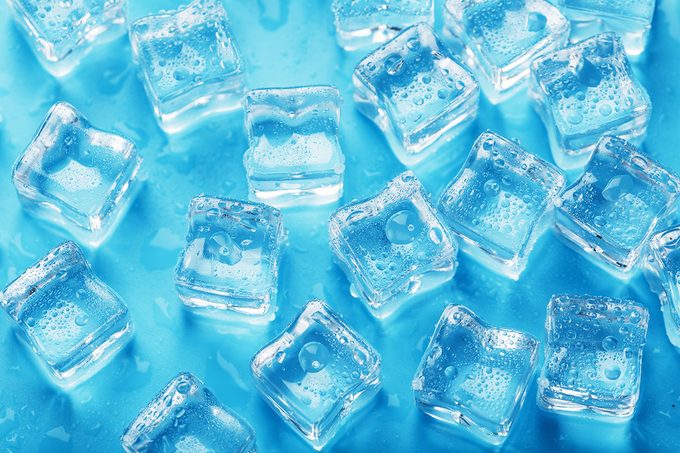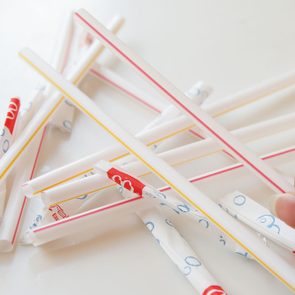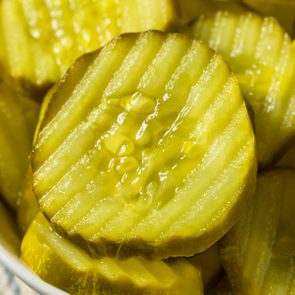It’s not a random choice, and the history of ice cubes is a lot (ahem) cooler than you probably think

This Is the Real Reason Why Most Ice Cubes Are Square

I’m a part-time teacher, and I recently needed an object lesson for my high school students. So I went with building arches out of ice—because 1) I knew the kids would get a kick out of playing with ice, and 2) the cubes’ square-ish, rectangle-ish (rhomboid? Don’t judge me, I don’t teach math) shape makes them weirdly perfect for self-supporting arches. Bonus: I could throw them on the lawn when finished, making cleanup a breeze, unlike that time I let them make slime.
But until that lesson, I had never actually thought about why ice cubes are shaped that way. Is everyone secretly building ice arches?
Ice has existed since the world began (it’s … frozen water), but it’s been widely available for chilling drinks and coolers only since the early 19th century. But why are these modern miracles square? Not spherical. Not triangular. Not shaped like tiny dolphins wearing sunglasses (tragically). Square.
Someone, somewhere, at some point had to make that call. And there has to be a reason. And what about all those other wild ice shapes out there that have started popping up in cocktails recently? I had questions, so I reached out to two people who literally study ice for a living: food scientist Bryan Quoc Le, PhD, the author of 150 Food Science Questions Answered, and Camper English, the author of The Ice Book and the genius behind an at-home clear-ice hack now used all over the world. Together, they helped me crack the code on ice-cube geometry. (Which is weirdly a sentence I’ve now said twice in my life. Huh.)
Turns out, that classic ice-cube shape isn’t just tradition—it’s efficiency, physics and a touch of freezer engineering, Le says. But there’s more. Much more. Below, we dive into the slippery, surprisingly riveting world of ice-cube design.
Get Reader’s Digest’s Read Up newsletter for more common curiosities, humor, travel, tech and fun facts all week long.
Why are most ice cubes square?

It boils (freezes?) down to three main reasons: Rectangular ice cubes are traditional, the easiest to store and produce, and hit the sweet spot between cold and water.
It starts with the trays
Before we get to that, it’s important to remember this history tidbit: The OG ice cubes weren’t made in trays at all. “The original ice cubes were sawed off a huge ice block harvested from lakes, or chipped off the blocks with an ice pick,” explains English. This was in the early 1800s, before artificial refrigeration. Back then, if you wanted ice, you were basically doing woodworking with frozen lakes.
Ice-cube trays came on the scene in the early 1900s, but the square tray we all know and mildly resent became widespread in the 1930s and ’40s. This flexible, all-metal tray with 14 square holes was invented in 1933 by Guy L. Tinkham, vice president of the General Utilities Manufacturing Company, and he sold them for 50 cents.
Modern rectangular cubes, though? “They are relatively easy to produce with minimum excess in a grid ice tray,” Le says. Once metal and plastic trays became common in the 20th century, square or rectangular molds just made the most sense—no wasted space, no weird gaps, no overcomplicated designs.
They’re stackable
And that stackable design still wins today. “The rectangular shape is relatively easy to stack and allows manufacturers to minimize the amount of air space between ice cubes,” said Le. This makes production and storage more efficient, whether you’re filling a cooler or stocking a fast-food soda fountain.
English agrees and notes that he prefers 1.25-inch square cubes. “Those are nice and solid because they’re square and they stack nicely in a glass,” he says. I love a person who not only knows precise ice-cube dimensions but also has a favorite!
Cubes stay cold longer
Square cubes hit a sweet spot: enough surface area to cool your drink quickly, and enough volume to avoid melting instantly, Le says. They’re not flashy, but they get the job done—perfect for casual sipping or chucking into a shaker.
“Regular ice cubes from an ice-cube tray are probably the most useful,” English adds. “They’re ideal in the cocktail shaker, [and] they crack open easily.”
Bonus: Versatility
This wasn’t on the experts’ lists, but it is on mine: flavored ice! I love freezing random stuff in ice cube trays—berries, cucumbers, flowers—and dropping the ice in drinks. It’s hard to do that with any other ice shape.
Why isn’t all ice in this shape?
If you’re like me, you’re already wondering: If cubes are so universally handy, why do your fridge’s ice makers churn out little crescent moons?
It’s all about mechanics, Le says. “The crescent-shaped ice that is formed by the freezer in the fridge is produced that way to make it easier for the mechanism inside to tip the ice over after the water has frozen into ice.” Rounded edges make the pieces slide out smoothly so the ice machine doesn’t jam up every three hours.
Many other shapes exist, however, because they each fill different purposes:
-
Melts faster or slower, depending on need
-
Looks cool (aesthetics matter—just ask anyone who’s ever Instagrammed a cocktail)
-
Is optimized for certain drinks or applications, like commercial ice machines
-
Just brings joy, like the Sonic-style nugget ice that makes people irrationally happy
What are the various ice shapes best for?
As we noted before, different drinks (ideally) call for different ice shapes. Here’s the expert-approved list that goes beyond mere cubes:
- Large spheres: These orbs are the slowest melters. “Large spheres have the lowest surface-area-to-volume ratio,” English says. “They are ideal for neat spirits, as well as keeping certain cocktails cool without adding too much dilution.” Le agrees, calling them “best for minimum surface area, which reduces the speed at which the ice melts.” Whiskey, meet your soulmate.
- Crushed ice: Want fast chill and big dilution? Crushed ice is your guy. “It’s ideal for iced coffee and traditional in tiki or tropical cocktails,” English says. It also makes your glass—and hand—cold, which boosts the chill factor. Le adds that crushed ice “melts rapidly and cools beverages quickly.”
- Nugget ice (aka pellet or Sonic ice): Great for sodas, lemonades and chewing ice like a gremlin (hi, Dad!). “It has a desirable mouthfeel,” Le says. Basically, it’s the ice that people form emotional attachments to. I actually have a friend who purchased her own nugget machine and invites people over just to have sodas with the ice in it and chill (which is a pretty awesome way to spend an afternoon).
- Collins spears: These long, slender rods are perfect for tall drinks. They’re the Audrey Hepburn of ice—elegant and practical. Even better, they never over-dilute a gin and tonic.
- Theme shapes: Stars, dinosaurs, flowers—there’s an ice shape for every occasion. “These are made for holidays and festivals,” Le says, adding that they’re also great for kids’ drinks and cocktail parties that need dolphins.
- Crescent ice: This fridge-friendly shape exists purely for mechanical reasons. This ice may not win any beauty contests, but it won’t clog your ice dispenser either.
- Snow/shaved ice: The fluffiest form, and my personal favorite. “It’s best for absorbing flavors, such as from syrups, and to produce slushies,” Le says. English adds that “snow is even more extreme than crushed ice” when it comes to rapid melting and sweet soaking. And I can attest to this—I will drive many miles for a shaved ice made with “ice snow” rather than the gritty ice pebbles they put in snow cones.
- Bullet or pearl ice: Small, cylindrical and often hollow, “these have a desirable crunchiness and texture,” Le says. This makes them great in iced coffee or soft drinks—and for breaking the office ice. (Sorry, my dad-joke meter is set to high.)
- Clear artisanal cubes: These are where English shines. He’s famous for developing a global at-home method for making perfectly clear ice. “Clear ice does melt a bit more slowly than cloudy ice, but it just looks a lot nicer when it is clear,” he says. “You can drink champagne out of a paper cup or a crystal flute and technically the champagne is the same, but the experience with the flute is just much more enjoyable. It’s the same with ice—clear ice is prettier.”
- Ice shards: These result from attacking a sealed ice bag with a knife. (We’ve all been there!) Best for: expressing big feelings.
So what is the optimal shape for an ice cube?
All right, if we’re being scientific about it (because nothing screams “science” like obsessing over frozen water), the ideal ice cube depends on your priorities. According to thermodynamics, the rate at which ice melts depends on the surface-area-to-volume ratio. The higher the surface area compared with the volume, the faster it melts. That’s why those giant spheres dominate the fancy bar scene—they’re slower to melt but still keep your drink cool. Meanwhile, tiny shards melt faster than you can say “Whoops, watery wine.” So, if you:
-
Want your drink cold fast? Go for crushed ice. More surface area = rapid cooling.
-
Want minimal dilution? Choose a large sphere. Less surface area = slow melt.
-
Want to not overthink this and still be fine? Stick with your basic square cube, the Swiss Army knife of the freezer world. The humble square walked so the spheres could roll.
That said, I posed this ultimate question to our experts: If you could choose only one type of ice, which should it be?
Le’s verdict: “There’s no optimal shape for an ice cube. Each has its own uses and optimal conditions.” But at home, he prefers “large spheres and cubes, as they help keep beverages cold for longer without diluting them so rapidly.”
English’s verdict: For him, the OG square cube wins in terms of versatility. “The standard ice-cube tray cube is the One Cube to Rule Them All,” he says. While those are usually rectangular, he specifically likes the 1.25-inch square-cube ice—the best for solidity, stackability and shaker-friendliness. Bonus if they’re clear, of course.
My verdict: Dolphins, obviously.
But the best ice isn’t always about physics. Sometimes it’s about doing what makes you happy. If crushing nugget ice between your molars brings you joy, then that is the optimal ice … for you.
RELATED:
- Here’s the Real Reason You Always Have Room for Dessert, According to Science
- Here’s Why an Espresso Martini Is Garnished with Three Coffee Beans
- Here’s the Real Reason You Can’t Find Coke with Real Sugar in the U.S.
About the experts
|
Why trust us
At Reader’s Digest, we’re committed to producing high-quality content by writers with expertise and experience in their field in consultation with relevant, qualified experts. We rely on reputable primary sources, including government and professional organizations and academic institutions as well as our writers’ personal experiences where appropriate. For this piece on why most ice cubes are square, Charlotte Hilton Andersen tapped her experience as a longtime journalist who specializes in common curiosities for Reader’s Digest. We verify all facts and data, back them with credible sourcing and revisit them over time to ensure they remain accurate and up to date. Read more about our team, our contributors and our editorial policies.
Sources:
- Bryan Quoc Le, PhD, food scientist, founder of Mendocino Food Consulting and author of 150 Food Science Questions Answered; phone interview, June 19, 2025
- Camper English, expert mixologist, founder of Alcademics and author of The Ice Book; email interview, June 19, 2025



